Comments / Questions (61)
![]() Fengyi wrote:
Fengyi wrote:
I want to make the jacket with drops air, just wondering if the shape would be a bit different as the weight should be different? (600grams using air vs 900grams using Andes) Would you recommend using drops air to make this jacket?
17.04.2025 - 15:36DROPS Design answered:
Dear Fengyi, this pattern is for a Group E yarn, so to use a group C yarn, like DROPS Air, you will need to work with double thread. DROPS Air, specifically, is a very light yarn so it won't have as much weight and won't fall as nicely. But as long as you work in double thread it should be possible to work with DROPS Air. Happy knitting!
20.04.2025 - 22:07
![]() MAYRA GARCIA wrote:
MAYRA GARCIA wrote:
POR FAVOR ME PODRIAN INDICAR EN LA PARTE DE LA ESPALDA CUANTOS PUNTOS HAY QUE DEJAR PARA LA CAPUCHA Y LOS HOMBROS PARA UNA TALLA XL GRACIAS
14.12.2024 - 04:34DROPS Design answered:
Hola Mayra, la capucha se trabaja recogiendo puntos alrededor de todo el cuello, incluyendo los puntos en un gancho auxiliar en el delantero. En principio, usarás para recoger los 10 puntos cerrados en el cuello en la espalda. Después de cerrar los 10 puntos deberías tener 40 puntos (o 20 puntos en cada hombro); cierras 1 punto más en cada hombro = 19 puntos en cada hombro.
15.12.2024 - 22:23
![]() Rosemarie Olivebring wrote:
Rosemarie Olivebring wrote:
Denna var väldigt rolig och enkel att sticka. Härligt garn! 😊
14.03.2024 - 07:09
![]() Barbara Boyer wrote:
Barbara Boyer wrote:
I have knitted this cardigan and as a beginner found the pattern clear and easy to follow. I am delighted with the result
07.02.2023 - 14:31
![]() Maureen Pinwill wrote:
Maureen Pinwill wrote:
I have knitted this delightful jacket with Drops Andes Dark Brown Yarn. I am absolutely delighted with the finished garment. Congratulations to the designer. It is so cosy and warm. I am sure I will knit another in a different colour.
01.12.2022 - 19:07
![]() Batia wrote:
Batia wrote:
How can i buy wool ? beacuse i can't find the place in your web site. i would like to order 10 pices of DROPS Andes "misty rose" . thx for your help.
31.08.2022 - 14:05DROPS Design answered:
Dear Batia, you will find the list of DROPS Stores shipping worldwide here - click on the desired store to open their website and place your order there. Don't hesitate to contact them per mail for any further information. Happy knitting!
31.08.2022 - 15:08
![]() Helen Goodson wrote:
Helen Goodson wrote:
When slipping the stitches onto a stitch holder towards the end on the left and right front pieces are the first 7 stitches slipped from the garter stitch rows (where the button holes are) or from the moss stitch side ?
18.02.2022 - 10:12DROPS Design answered:
Dear Mrs Goodson, on left front piece, work the first 7 sts (then the first stitch) at the beginning of a row from wrong side then slip them/it on a thread; on right front piece, work the first 7 (then the first stitch) at the beginning of a row from right sdie and then slip them/it on a thread - so that you don't need to cut yarn. The first 7 sts from RS/WS are the 7 front band sts, then slip the next 3 or 4 sts (see size) = sts in moss stitch. When working hood, you will then knit up these stitches on both front pieces. Happy knitting!
18.02.2022 - 14:21
![]() Sandra wrote:
Sandra wrote:
Ya llevo los 70 cm de la espalda para talla S y no se cómo seguir con las disminuciones del cuello, no entiendo bien el final :(
22.01.2021 - 22:56DROPS Design answered:
Ver la respuesta abajo.
23.01.2021 - 20:12
![]() Sandra wrote:
Sandra wrote:
Hola! Podríais resolverme la siguientes dudas? En la explicación final de la espalda que dice: En una vuelta se rematan para el cuello 8 pts al volver otros 8pts la siguiente vuelta 10pts y así sucesivamente? O solo una vez 8pts de ida y vuelta o sea 16 pts (para la tallaS). Por otra parte dice “rematar 1pts en la vta a partir del cuello= ¿¿14 veces de ida? Gracias por vuestra atención!
19.01.2021 - 23:45DROPS Design answered:
Hola Sandra. Los patrones de DROPS están preparados para las tallas S-XXXL. Si hay varios números, significa que el primer número es para la talla S, el 2º para la talla M, etc. Si hay solo un número, entonces es igual para todas las tallas. En tu caso, en la espalda para el escote hay que cerrar primero 8 puntos y después 1 punto a cada lado en el escote (un total de 10 puntos), cada hombro se termina por separado. Los 14 puntos son los puntos restantes para el hombro.
23.01.2021 - 20:10
![]() Derock wrote:
Derock wrote:
Bonjour, j'aurai voulu tricoter la capuche séparément puis la coudre mais je ne sais pas combien de mailles je dois monter en taille m ? Merci à vous et bravo pour vos superbes modèles
17.01.2021 - 13:53DROPS Design answered:
Bonjour Mme Derock, les mailles de la capuche doivent être relevées, et le nombre va varier en fonction de votre tension en hauteur notamment - vous pouvez peut-être essayez de mesurer la longueur de l'encolure et de calculer ainsi le nombre de mailles qu'il vous faudra. Bon tricot!
18.01.2021 - 09:52
Aurora#aurorajacket |
|
 |
 |
Knitted DROPS jacket in seed st with hood in ”Andes” or ”Snow”. Size: S - XXXL
DROPS 132-9 |
|
|
SEED ST: 1st row: * K 1, P 1 *, repeat from *-*. 2nd row: K over P and P over K. Repeat 2nd row. GARTER ST (back and forth on needle): K all rows. MEASURING TIP: Because of the weight of the garment all measurements must be done by holding the piece up otherwise the garment will be too long when worn. BUTTON HOLES: bind off for button holes on right front band.1 button hole = K 3rd and 4th st from mid front tog, then make 1 YO. Bind off for button holes when piece measures: SIZE S: 19, 28, 37, 46, 55 and 64 cm / 7½",11",14½",18",21½" and 25¼" SIZE M: 21, 30, 39, 48, 57 and 66 cm / 8¼",11¾",15¼",19",22½" and 26" SIZE L: 23, 32, 41, 50, 59 and 68 cm / 9",12½",16⅛",15¾",23¼" and 26¾" SIZE XL: 20, 30, 40, 50, 60 and 70 cm / 8",11¾",15¾",19¾",23⅝" and 27½" SIZE XXL: 22, 32, 42, 52, 62 and 72 cm / 8¾",12½",16½",20½",24⅜" and 28⅜" SIZE XXXL: 24, 34, 44, 54, 64 and 74 cm / 9½",13⅜",17¼",21¼",25¼" and 29⅛" KNITTING TIP (applies to hood): To avoid holes in the transitions where sts for neck were slipped on a stitch holder, pick up the yarn between 2 sts and work this strand tog with 1st st on row. -------------------------------------------------------- BACK PIECE: Worked back and forth on needle. Cast on 50-54-58-62-68-72 sts on needle size 10 mm / US 15 with Andes. Work in SEED ST - see explanation above! REMEMBER THE GAUGE! When piece measures 8 cm / 3⅛" - READ MEASURING TIP - dec 1 st in each side. Repeat dec every 8 cm / 3⅛" a total of 6 times = 38-42-46-50-56-60 sts. When piece measures 53-54-55-56-57-58 cm / 21"-21¼"-21⅝"-22"-22½"-22¾", insert 1 marker in each side (marks where armhole starts). When piece measures 70-72-74-76-78-80 cm / 27½"-28⅜"-29⅛"-30"-30¾"-31½, bind off the middle 8-8-10-10-10-10 sts for neck and finish each shoulder separately. Then bind off 1 st on next row from neck = 14-16-17-19-22-24 sts. Bind off when piece measures 72-74-76-78-80-82 cm / 28⅜"-29⅛"-30"-30¾"-31½"-32¼". LEFT FRONT PIECE: Worked back and forth on needle. Cast on 30-32-34-36-39-41 sts (includes 7 band sts towards mid front) on needle size 10 mm / US 15 with Andes. Work in GARTER ST - see explanation above - over the 7 band sts towards mid front and Seed st over the remaining sts. When piece measures 8 cm / 3⅛", beg to dec in the side as on back piece = 24-26-28-30-33-35 sts. When piece measures 53-54-55-56-57-58 cm / 21"-21¼"-21⅝"-22"-22½"-22¾", insert 1 marker in the side (marks where armhole starts). Continue to work until piece measures 66-68-70-72-74-76 cm / 26"-26¾"-27½"-28⅜"-29⅛"-30". Now slip sts on beg of every row from neck on 1 stitch holder (after they have been worked to avoid cutting the thread) as follows: 7 sts 1 time and 1 st 3-3-4-4-4-4 times = 14-16-17-19-22-24 sts remain on shoulder. Bind off when piece measures 72-74-76-78-80-82 cm / 28⅜"-29⅛"-30"-30¾"-31½"-32¼". RIGHT FRONT PIECE: Cast on and work as left front piece but reversed. In addition bind off for BUTTON HOLES on band - see explanation above! SLEEVE: Worked back and forth on needle. Cast on 24-24-26-26-28-28 sts on needle size 10 mm / US 15 with Andes. Work 8 rows in Garter st, continue in Seed st. At the same time when piece measures 12 cm / 4¾", inc 1 st in each side. Repeat inc every 8-7-7-5-5-4 cm / 3⅛"-2¾"-2¾"-2"-2"-1½" a total of 5-6-6-7-7-8 times = 34-36-38-40-42-44 sts. When piece measures 52-50-49-47-45-43 cm / 20½"-19¾"-19¼"-18½"-17¾"-17", loosely bind off all sts. NOTE: Shorter measurements in the larger sizes because of wider shoulder width. ASSEMBLY: Sew the shoulder seams. Sew in sleeves – see markers on front and back piece for where the sleeves should start. Sew sleeve and side seam in one, sew tog edge to edge in front loop of outermost st to avoid a chunky seam. Sew on buttons. HOOD: Pick up approx. 35 to 42 sts around the neck (including sts on stitch holders at the front) on needle size 10 mm / US 15 with Andes. K 1 row from WS while AT THE SAME TIME working to avoid holes in the transitions at the front of neck – READ KNITTING TIP. Then work 8 rows in Garter st. On next row from RS, inc evenly to 48-50-52-54-56-58 sts. NOTE: Do not inc over the outermost 7 sts in each side (= front bands). Continue in Garter st over the outermost 7 sts in each side and Seed st over the remaining sts until hood measures 47-47-48-48-49-49 cm / 18½"-18½"-19"-19"-19¼"-19¼", bind off. Fold the hood double and sew it tog at the top, sew edge to edge to avoid a chunky seam. |
|
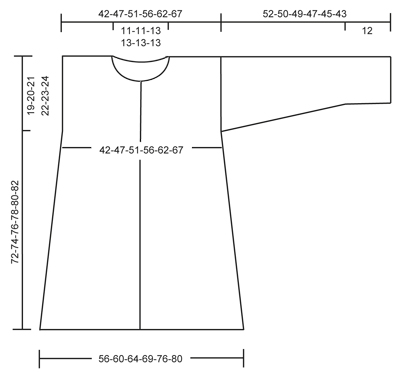 |
|
Have you finished this pattern?Tag your pictures with #dropspattern #aurorajacket or submit them to the #dropsfan gallery. Do you need help with this pattern?You'll find 10 tutorial videos, a Comments/Questions area and more by visiting the pattern on garnstudio.com. © 1982-2026 DROPS Design A/S. We reserve all rights. This document, including all its sub-sections, has copyrights. Read more about what you can do with our patterns at the bottom of each pattern on our site. |
|








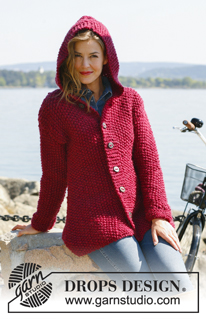



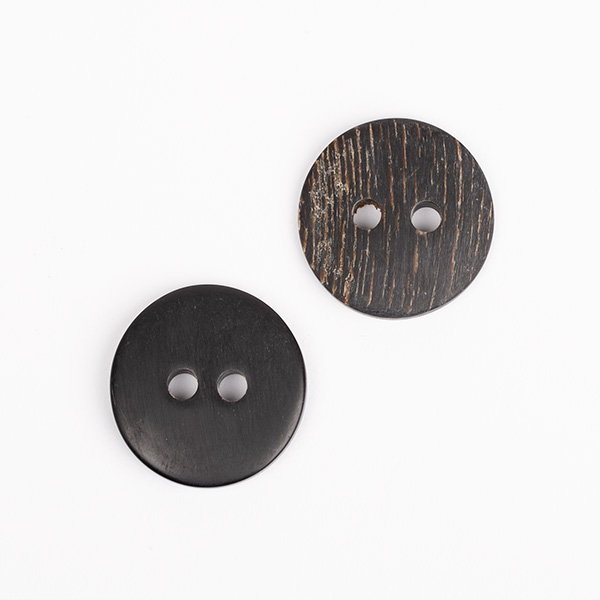

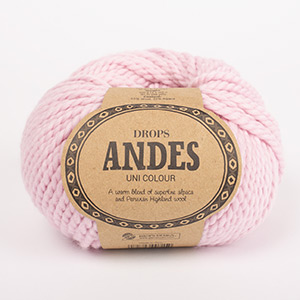
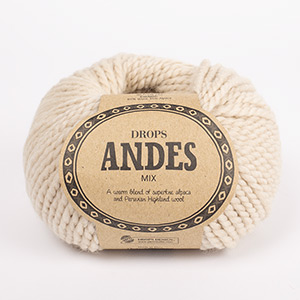
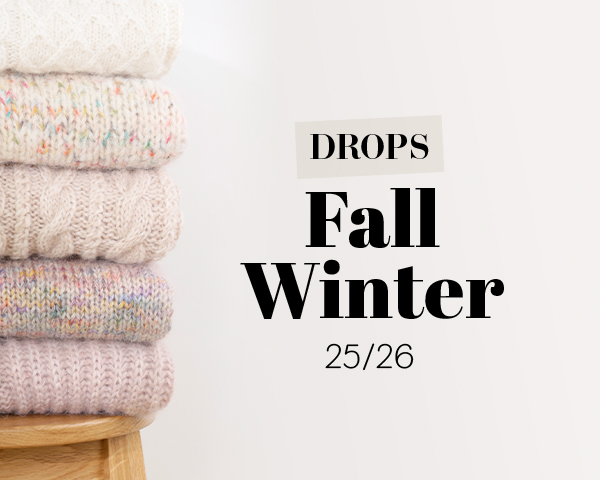





















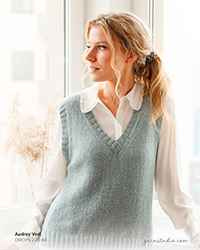

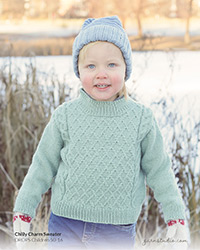
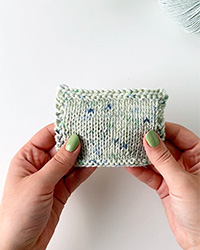

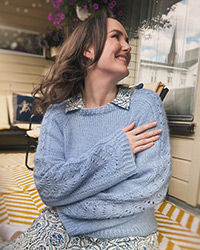
Post a comment to pattern DROPS 132-9
We would love to hear what you have to say about this pattern!
If you want to leave a question, please make sure you select the correct category in the form below, to speed up the answering process. Required fields are marked *.